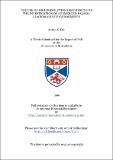Files in this item
The use of high resolution geophysics for the investigation of submerged palaeo-glaciomarine environments
Item metadata
| dc.contributor.advisor | McManus, John | |
| dc.contributor.advisor | Ballantyne, Colin | |
| dc.contributor.author | Dix, Justin K. | |
| dc.coverage.spatial | 414 p. | en_US |
| dc.date.accessioned | 2018-07-12T08:23:09Z | |
| dc.date.available | 2018-07-12T08:23:09Z | |
| dc.date.issued | 1996-07 | |
| dc.identifier.uri | https://hdl.handle.net/10023/15271 | |
| dc.description.abstract | A multi-disciplinary, high resolution, geophysical investigation of a Scottish Sea loch has facilitated both the reconstruction of a detailed late Quaternary para-stratigraphic model and the critical assessment of the acquisition and analytical methodologies most appropriate for the study of submerged palaeo-glaciomarine environments. Loch Ainort, situated on the eastern coast of the Isle of Skye, has been surveyed using a 192 kHz echosounder, a 400 kHz side scan sonar and a 3.5 kHz sub-bottom profiler. Lithological calibration was provided by the analysis of both in situ core data and extant terrestrial data sets. It is proposed that for the effective reconstruction of these and any other nearshore palaeo-environments a multi-disciplinary geophysical approach is essential. The critical control on success is the adherence, during interpretation, to a single unifying seismo-analytical framework. The seismo-stratigraphical analysis technique has been adapted for high- resolution work in order to provide this rigid framework. Objective descriptive analysis of the seismic traces provides a "seismic para-stratigraphy" which when combined with lithological data is used to construct a "composite para-stratigraphy". This is a process based, litho-stratigraphic interpretation that, by virtue of the detailed spatial extent afforded it by geophysical data, can be placed in a wider environmental context. The composite para-stratigraphy for the Loch Ainort basin is dominated by Loch Lomond Stadial glacial activity. Terminal and readvance limits are identified at several localities within the basin. Variable morphological styles of the glacial sequences show that deglaciation occurred in two distinct, climatically controlled, phases. The first marked by a fluctuating ice margin and the second by uninterrupted retreat and in situ ice stagnation. Sub-aerially induced debris flows occur during the initial paraglacial phase but stabilisation of exposed slopes restricts this input and rapid sedimentation of fines from sediment-rich meltwaters becomes dominant. Modern fjordic sedimentation develops after the disappearance of glacier ice. | en_US |
| dc.language.iso | en | en_US |
| dc.publisher | University of St Andrews | |
| dc.subject.lcc | QE697.D5 | |
| dc.subject.lcsh | Glacial epoch | |
| dc.subject.lcsh | Glaciation | |
| dc.title | The use of high resolution geophysics for the investigation of submerged palaeo-glaciomarine environments | en_US |
| dc.type | Thesis | en_US |
| dc.type.qualificationlevel | Doctoral | en_US |
| dc.type.qualificationname | PhD Doctor of Philosophy | en_US |
| dc.publisher.institution | The University of St Andrews | en_US |
This item appears in the following Collection(s)
Items in the St Andrews Research Repository are protected by copyright, with all rights reserved, unless otherwise indicated.

